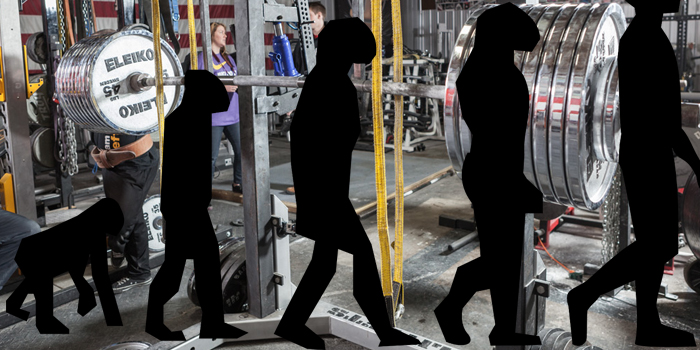
“A basic prediction of evolutionary or Darwinian medicine is that the human foot is likely to be well adapted to running long distances barefoot. If so, then contrary to popular belief, the bare foot may be well suited for running long distances without requiring modern, heavily cushioned, high-heeled running shoes. “
Why does this matter? Why should a weightlifter care about what long distance runners are doing? Here is an interesting thought: If the human foot is designed to operate barefoot during running, then is it possible that the human foot is also designed to operate barefoot during squatting, deadlifting and other knee bending movements? Though not tested, the Harvard lab hypothesizes and acknowledges anecdotal evidence supporting that barefoot running can help athletes avoid or alleviate common injuries derived from the foot or lower leg. The question every weightlifter should ask themselves, is if this idea can be used to extrapolate information regarding barefoot squatting. Does it stand to reason that barefoot knee bending movements also help athletes avoid or alleviate injuries?
Interestingly, the lab discusses the differences in shod running vs. barefoot running. The differences in overall body mechanics and the way in which the body handles forces are quite distinct. They discuss that barefoot running mechanics may result in reduced impact forces, which may lower rates of injury. Lastly, positive attributes weight lifters can take notice of regarding barefoot running include:
- Stronger muscles in the feet (perhaps because they are used more)
- Stronger foot arch
- More energy efficient gate
- Utilization of the vast network of sensory nerves on the bottom of the feet
- Minimal impact forces on landing.
All in all, if the skeleton is a linked kinematic chain, then it is important for any athlete to consider how the feet are behaving as they may have important consequences for the rest of the joints (knees, spine, etc.).
"Unfortunately, studies suggest that at least 30% of runners get injured every year, and many of these injuries stem from problems that arise in the foot or lower leg (van Gent et al., 2007)."
"These kinds of strikes (i.e. landing first on the lateral ball of the foot) lead to lower impact forces which may lead to lower rates of injury."
"We hypothesize and there is anecdotal evidence that forefoot or midfoot striking can help avoid and/or mitigate repetitive stress injuries, especially stress fractures, plantar fasciitis, and runner's knee. We emphasize, however, that this hypothesis on injury has yet to be tested and that there have been no direct studies on the efficacy of forefoot strike running or barefoot running on injury."
- "It strengthens the muscles in your foot, especially in the arch. A healthy foot is a strong foot, one that pronates less and is less liable to develop a collapsed arch.
- It may cost less energy to forefoot strike because you use the natural springs in your foot and calf muscles more to store and release energy. Running barefoot or in minimal footwear (usually lighter than traditional running shoes) means that there is less mass to accelerate at the end of the runner's leg with each stride.
- Running barefoot has been shown to use about 5% less energy than shod running (Divert et al., 2005; Squadrone and Gallozzi, 2009).
- Barefoot running feels great! Your feet have lots of sensory nerves. And because there is minimal impact forces on landing it can be very comfortable provided you develop calluses on your feet (see below)."
Also be sure to check out “The Importance of Barefoot Training” by Martin Rooney.








